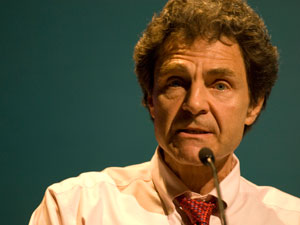 |
| Eric Booth will speak at SETC in Louisville. |
By Carmen Marti
Entire contents are copyright © 2013 Carmen Marti. All rights reserved.
Eric Booth’s biggest role is played off stage.
A teaching artist (artist–educator) is a practicing professional artist with the complementary skills and sensibilities of an educator, who engages people in learning experiences in, through, and about the arts.
—Eric Booth
When the 64th Annual Southeastern Theatre Convention, the largest theater conference in the United States, convenes in Louisville in March, it will open with the work and words of Eric Booth, the actor who has become known around the world as the father of the teaching artist profession.
On March 6, Booth will not only run the day-long Teachers Institute seminar “So what does Creativity have to do with Learning? With Teaching? With the Future of Education?” – he will also address the convention as the opening night keynote speaker.
Teaching and helping artists work as educators – in the academic classroom, corporate boardroom and nonprofit conference room – is a role Booth has been playing now for more than three decades. “I realized my curiosities were reaching beyond a theater person’s work,” he explains about his transition from stage to consultant, author and businessman. “I was hungry for more.”
So Booth taught himself to be a teaching artist, started consulting, became an author and established a publishing house. He has taught at Stanford, NYU and Juilliard, among other universities; gained an honorary degree from the New England Conservatory; and was founding editor of Teaching Artist Journal, the first peer-reviewed journal for teaching artists. “My work is relatively random,” Booth says. “I take projects no one has done before.”
His gift, he says, “is to be able to talk to arts leaders and practitioners in an inside/outside way. I learned the inside of being an artist the hard way. Now I’ve spent so much time on the outside with outsiders, I know that world too.”
Booth has learned in particular how to navigate the world of education, the area he will address in Louisville. His main message: What does creativity mean? What are the creative skills? How do you develop creativity and where can it developed? How does that fit in the development of young artists? If you’re a teacher, are you willing to become a resource for developing creative capacity in the schools where you teach?
“If all goes well, people will have a fresh vocabulary for doing the things they already do well,” Booth says. “The skills [administrators] want education to train are the skills artists train. I hope to enable participants to intensify certain aspects of their work and make it applicable in areas where they’ve had difficulty. I hope to provoke experimentation they can open up in their work.”
Essentially, Booth will be in Louisville to underscore the fact that creativity is gaining credibility and artists can capitalize. “The professional world is finding that theater people are extremely valuable in other fields,” Booth explains. “They are coming to us finally. After all these years of standing on the periphery, we’re more and more drawn into the conversation. Until now, others outside the arts were teaching creativity.”
In some ways, it’ been a matter of semantics and adjustment. “We’re teaching creativity, not art,” Booth explains. “Art is indulgent. Creativity is something we need.
“But basically I do the kind of work I’d do in any creativity workshop. They’re theater exercises, but I don’t call them that. We role-play; we do team building. We don’t have to step off the line of our artistry or change what we do well. We can expand what we do well. If we go beyond preconceptions about artists, there’s a lot we can do. It’s not just the sheer instrumentality of more gigs, but redefining how artists think of themselves and their skills, which provides a bigger container than we usually play in.”
And it provides results in the classroom. “There’s a sense that teachers of theater arts have ways to highly activate students,” Booth says. “We’re in a slow transition time. The dominant framework condemns the arts to remain on the periphery. The emerging framework – and the one I try to draw people into – is: Do you believe that every child deserves a highly engaging school day? Is there a connection between high engagement and better learning? What do you know about the research on high engagement? It makes the arts look good. We have a powerful set of tools for high engagement.”
And research is beginning to back Booth up. The first long-term study of arts in the classroom, UCLA professor James S. Catterall’s “Doing Well and Doing Good by Doing Art: A 12-Year Longitudinal Study” (2009), has shown that long-term involvement with the arts has a life-changing impact.
“Every year now there’s a new study,” Booth says. “There’s recognition that we don’t have a clear direction for making schools better. We’re actually falling further behind. That usually prompts change. I’m not at all as discouraged as some of my colleagues.”
In fact, Booth is encouraged. “I’m asking for people to use what we do and look for opportunities outside their original thinking,” he says. “We’re in a time of interdisciplinarity. It’s a disservice to not respond to the opportunities provided.”
The SETC 2013 Teachers Institute is a pre-convention seminar designed to engage, challenge and invigorate those who teach the arts as well as those who teach through the arts. The daylong program is open to the public, as well as convention attendees. Continuing Education Units and/or Professional development documentation offered.




